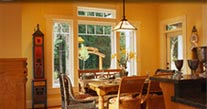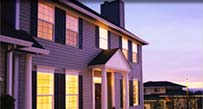Impact Windows: Which type is going to be right for you?
http://www.replacement-windows.com/windowbb/viewtopic.php?t=1320I am dropping a great deal of information - I don't know if it will help with your search, but it will make you a little more knowledgeable about impact windows, I think. Hope it helps!
I don't generally discuss specific manufacturers, but I do have a few thoughts to share concerning impact windows and their performance...and maybe a couple comments on the systems used by a few different manufacturers...
Impact windows are made with laminated glass, upgraded hardware, upgraded frames and other components, and all sealed in place with some of the strongest silicone (or other) adhesives on the market.
Virtually all the major window manufacturers have impact products available. Some perform extremely well, others barely get by.
Laminated glass is simply two (or more) lites of glass bonded to a plastic interlayer for strength. Laminated glass is no stronger against breakage than is the glass it is made of. Let me say that again - laminated glass breaks as easily as the glass it is made of. I mention that because many folks have the mistaken impression that laminated glass / impact windows won’t easily break. They will break, but the glass adheres to the plastic interlayer and keeps the envelope of the home closed.
There are four major food groups in the impact glass world (a few other minor ones as well) relating to the interlayers used to manufacture laminated glass.
First we have PVB or Polyvinyl Butyral. This is the stuff that is in the windshield of your car. It is relatively soft and very flexible, yet it is also tough and won’t tear easily. This is probably the most widely used product in the impact glass market. PVB does great when impacted. It stops whatever hits it and stretches to absorb the impact (such as a head in a car accident). The down side of PVB is that to achieve maximum stretchability the interlayer has to have a relatively loose bond to the glass substrate.
This lack of adhesion between the interlayer and the glass tends to make the product perform great in testing, but it is also results in some question with the products longevity without delamination when installed as a window. Delamination occurs when the interlayer simply loses its bond to the glass. If this happens, the glass wont fall the floor or anything quite that drastic, but it will begin to cloud up and for bubbles along the edges you may have seen this in car or (especially) bus or truck windshields.
There are two major players in the PVB market one of those two prefers the looser bond because the product does perform better in testing (and from their perspective in real life), the other interlayer manufacturer prefers a tighter bond for (presumed) longer life in the field while accepting that their product will not do as well in testing situations because of the tighter bond they do not believe that they lose anything in real life situations.
The second interlayer type is a hybrid of PVB with a layer of PET film between the PVB layers. This product was first introduced about 8 years ago by a laminated glass manufacturer who primarily used the higher bond product. The folks who produce the lower bond (or lower adhesion) product have recently (two years or so) their own version of this product. One reason it took them a long time to introduce their own version was because of adhesion issues between the PVB and PET film related to their lower adhesion product. They have since solved that issue.
Curiously, this product seems to be phasing out of the market although a number of window companies still offer it.
The third type of interlayer is called SGP or Sentry Guard Plus. This is quite a bit different from PVB in that it is stiff and very tough. It is distributed by the company that makes the higher adhesion product and is becoming the product of choice in some of the toughest applications (including bullet and bomb resistance). It is also expensive and may be overkill for some residential applications. This is also becoming the product of choice for a number of wood window manufacturers, although vinyl folks don’t seem to be using it quite as much. SGP stiffness tends to transfer an impact force to the frame of the window rather than absorbing the impact as does PVB. Many (but not all) vinyl windows simply aren’t strong enough to take that force. Some vinyl windows do quite well with SGP.
The fourth product is liquid laminate where a liquid resin is poured between two lites of glass and allowed to cure. I see liquid resin laminate as the Swiggle of laminated glass. It is cheap, it is relatively easy, and it is a good mom and pop shop product. I am not impressed with performance or longevity ¦my opinion only, but I wouldn’t use it in my house.
Most window manufacturers buy their laminated glass from a laminated glass manufacturer (which does make sense!) but a few laminate their own.
The major residential laminators (who are not window makers) are Cardinal, Old Castle, AFG, Arch Aluminum, Viracon and a few others.
Again, in general, Cardinal is almost entirely residential where the others mentioned are split between residential and commercial.
As a window company, PGT laminates most of their own glass and they are very good at it. They also outsource some laminated glass as well.
Simonton currently buys their laminated glass from one of the vendors I mentioned, but I believe that they are in the process of building their own line. I have also heard that they have partnered with a PVB supplier and are building a very experimental line that will change how laminated glass is made I have also heard that it is not proceeding very well at all. Time will tell.
PGT is primarily an aluminum window manufacturer. Their windows have done very well in the past few storm seasons. They are by far the largest seller of impact windows in the southeast (and probably everywhere else).
When buying IG (dual pane) windows, some manufacturers place the laminate to the exterior, and some to the interior. This is often based on how the window is glazed. The manufacturer wants to seal the laminated glass to the strongest component of the window / sash. Generally this is the "fixed" stop versus the removable stop.
If the window sash is "internally glazed" meaning that the removable stop is interior, then the laminate will be the exterior lite. If the window is "externally glazed" meaning that the removable stop is external, then the laminated glass is likely the inboard lite.
This isn’t 100% though. Some manufacturers prefer one version to another for other reasons such as keeping the laminated lite inboard to stop broken glass from coming into the home when the other lite is broken. If the non-laminate is to the interior and the laminate is impacted, then that other lite will break and the glass shards will be inside the home potentially violently. This can be avoided by placing the lami inboard.
As I said, this is a lot of information to absorb...I look forward to specific questions - have a great evening.
Source Post: Simonton vs. PGT vs. ViWinTech vs. Stanek - St Pete, FL
http://www.replacement-windows.com/windowbb/viewtopic.php?t=1320
Posted: Wed Mar 15, 2006 8:38 pm




 Call us at
Call us at


